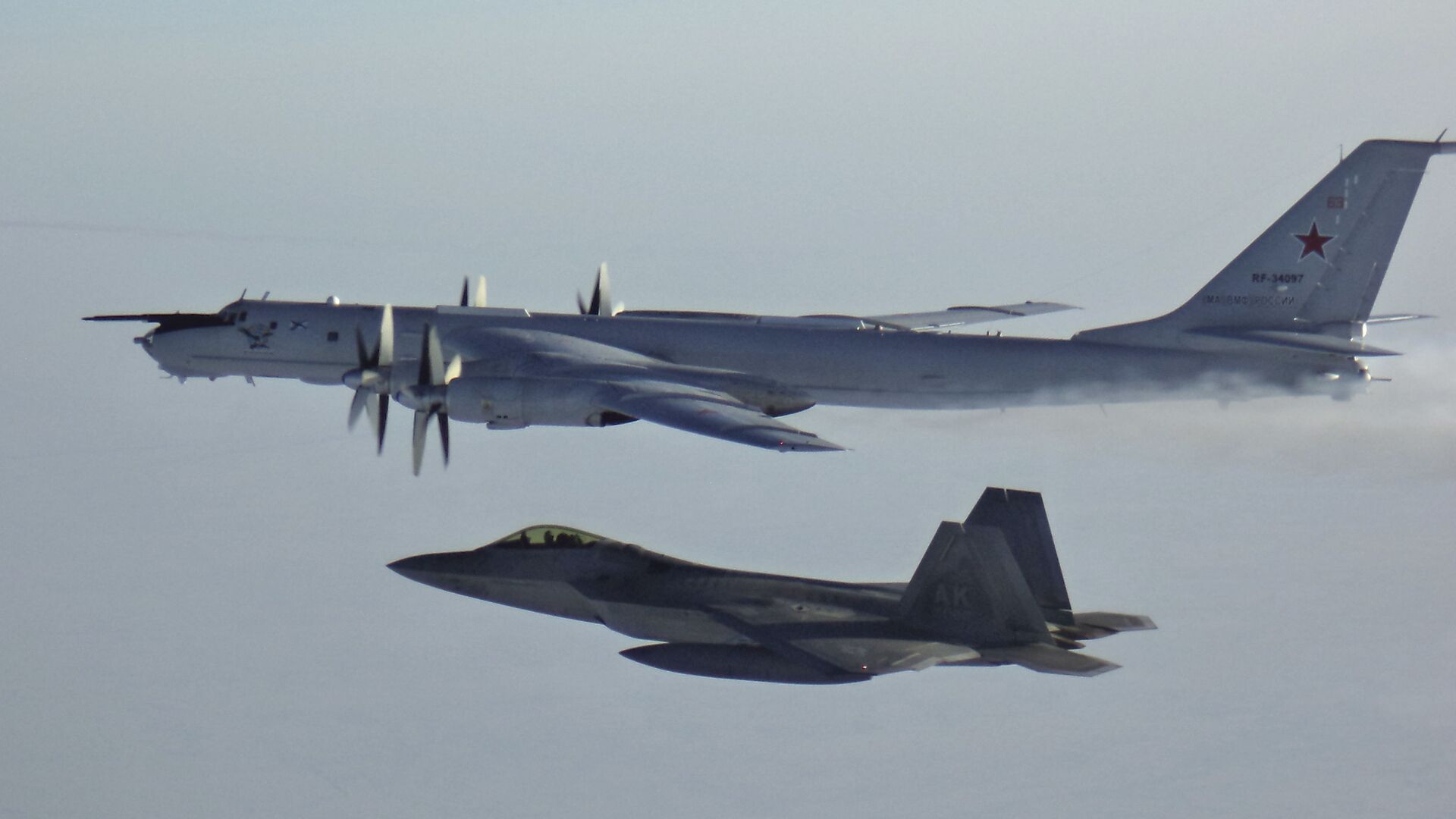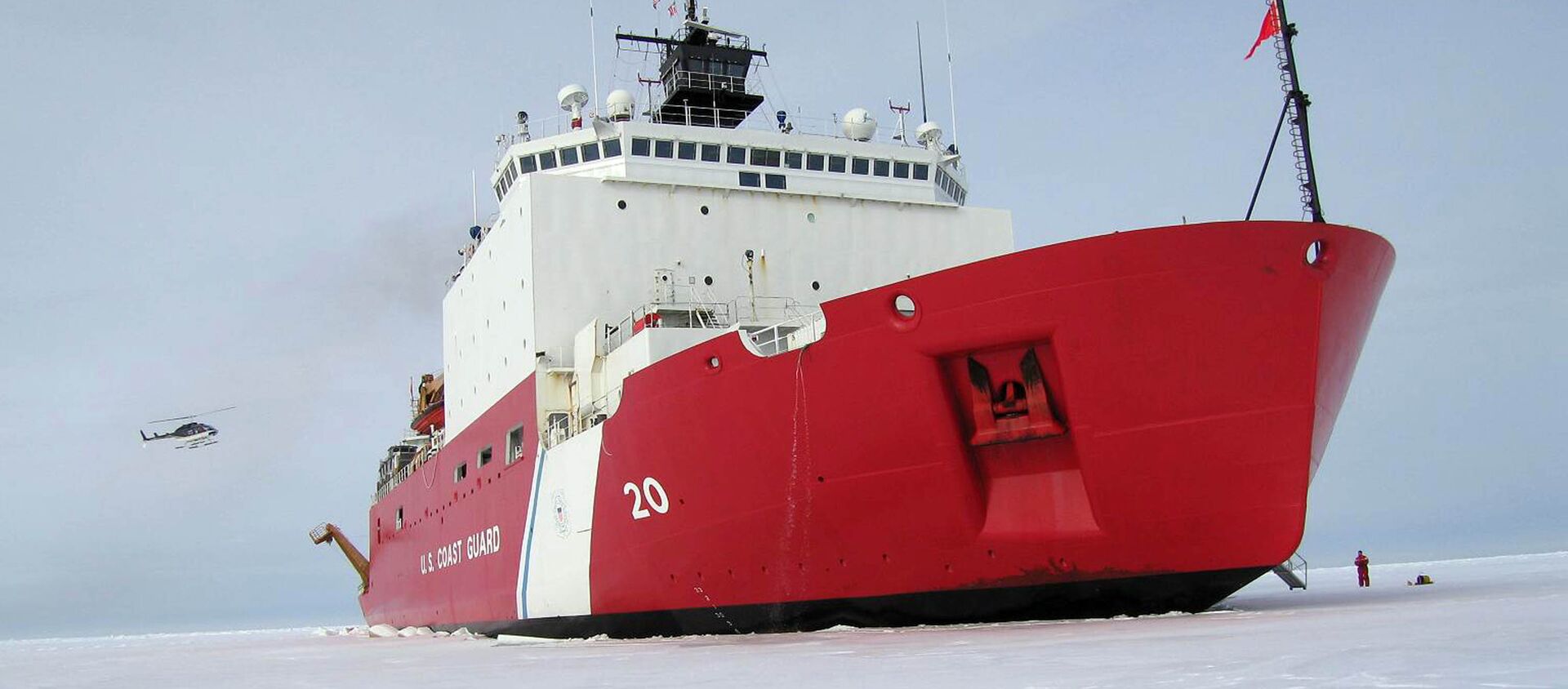https://sputnikglobe.com/20210728/us-air-force-says-its-intercepting-more-russian-jets-near-alaska-than-ever-since-cold-war-1083477582.html
US Air Force Says It’s Intercepting ‘More Russian Jets Near Alaska Than Ever Since Cold War’
US Air Force Says It’s Intercepting ‘More Russian Jets Near Alaska Than Ever Since Cold War’
Sputnik International
The Russian Aerospace Forces is known to occasionally send missile-carrying strategic bombers on patrols in neutral waters near Alaska, with the Pentagon... 28.07.2021, Sputnik International
2021-07-28T10:43+0000
2021-07-28T10:43+0000
2021-07-28T10:45+0000
military & intelligence
newsfeed
https://cdn1.img.sputnikglobe.com/img/107857/02/1078570263_0:156:3001:1844_1920x0_80_0_0_0cb9cd82e6c5091c7d8e651b4a7f79e2.jpg
S. Clinton Hinote, US Air Force Deputy Chief of Staff for Strategy, Integration and Requirements, has complained that Russia has dramatically ramped up the flights of military aircraft near Alaska last year as climate change continues to provide new opportunities for operations in the Arctic region.Pointing to a series of wargames his department has been conducting to determine “strategic threats” and how the US can “adopt to those threats,” the commander warned that America’s position in the Arctic leaves something to be desired at the moment.The commander added that the Pentagon was using wargaming to try to better understand how great power competition in Europe or the Asia Pacific region could “spill over into the Arctic, how our competitors could use the Arctic in a way of doing something strategically bad for the United States and for our allies and partners.”As far as Alaska is concerned, the general admitted that in addition to its use as a defensive base of operations, the strategic territory could also be used for offensive operations in Europe and Asia. “In essence you could conceivably do power projection sorties out of Alaska to both of those areas, and what we have seen in our wargaming is that it’s an incredibly effective place to base air operations out of.” This, he said, is why the US has been pouring in additional billions in defence dollars to beef up the Pentagon’s footprint in Alaska.‘New Theatre of Conflict’Hinote’s remarks about the supposed growing Russian threat to the Arctic comes amid growing concerns in Washington over Russia’s plan to develop its Arctic resources, to create a new Arctic trade route between Asia and Europe, and to improve security.In April, US Secretary of State Antony Blinken suggested that Russia’s sailing of a natural gas tanker through its Northern Sea Route and the construction of new military bases on Russian territory constituted evidence of a Russian plot to “exploit [climate] change to try to exert control over new spaces” in the Arctic.In January of this year, outgoing Navy Secretary Kenneth Braithwaite announced that the US would seek to carry out South China Sea-style ‘freedom of navigation operations’ in Russia’s Arctic maritime zones in an attempt to challenge Moscow’s claims to the region.The US Air Force deployment in Alaska is one of the largest contingents of US airpower globally. Last year, the Pentagon approved the deployment of 150 F-22 Raptors and F-35s to new and refurbished facilities at Eiselon Air Force Base. Alaska is also home to the Eleventh Air Force, operating-16 fighter jets, bombers and support planes out of Elmendorf-Richardson Joint Base Anchorage, Eiselon and Guam. The Eleventh Air Force is the US’s largest air contingent in the Northern Pacific region, operates several hundred planes total. The US is also beefing up its ground-based military presence in Alaska, building and expanding port facilities and constructing new icebreakers.By comparison, Russia’s military footprint in the Russian Far East and near Alaska is comparably modest, with its aircraft contingent consisting of interceptors based in Kamchatka, Sakhalin and the Naval Aviation component of the North Fleet, with a combined strength of about 60-63 planes. Last year, commenting on US plans to further beef up their Alaska deployment, Aerospace Forces Maj. Gen. Vladimir Popov told Sputnik that Russia’s strategy was defensive, and limited mostly to air defence and radar control systems.While it has accused Russia of an unprecedented escalation of bomber patrols near Alaska, the US military itself has dramatically expanded its ground, air and naval operations near Russia’s borders in Eastern Europe, the Black, Baltic, and Barents Seas, as well as the Sea of Japan. The Russian military has reported literally thousands of flights of bombers, fighters and reconnaissance drones in these areas in recent years, and performed hundreds of interceptions of aircraft when they approach to closely to Russian airspace.
https://sputnikglobe.com/20210629/us-coast-guard-considering-arctic-fonops-to-counter-russian-presence-at-north-pole-1083269415.html
https://sputnikglobe.com/20200926/why-pentagon-is-beefing-up-alaska-presence-literally-in-sight-of-russian-border-1080580212.html
Sputnik International
feedback@sputniknews.com
+74956456601
MIA „Rosiya Segodnya“
2021
News
en_EN
Sputnik International
feedback@sputniknews.com
+74956456601
MIA „Rosiya Segodnya“
Sputnik International
feedback@sputniknews.com
+74956456601
MIA „Rosiya Segodnya“
military & intelligence, newsfeed
military & intelligence, newsfeed
US Air Force Says It’s Intercepting ‘More Russian Jets Near Alaska Than Ever Since Cold War’
10:43 GMT 28.07.2021 (Updated: 10:45 GMT 28.07.2021) The Russian Aerospace Forces is known to occasionally send missile-carrying strategic bombers on patrols in neutral waters near Alaska, with the Pentagon maintaining a large garrison in the northernmost US-state.
S. Clinton Hinote, US Air Force Deputy Chief of Staff for Strategy, Integration and Requirements, has complained that Russia has dramatically ramped up the flights of military aircraft near Alaska last year as climate change continues to provide new opportunities for operations in the Arctic region.
“Not only is there a warming trend, but that’s allowing more activity. Interestingly, all that activity is not benign. So as an example last year, we intercepted more Russian military flights near Alaska than we have ever since the Cold War. So there is a trend not only of competition, but competition in the military realm,” Hinote said, speaking at a webinar hosted by the Woodrow Wilson Center, a Washington-based security-related think tank, on Tuesday.
Pointing to a series of wargames his department has been conducting to determine “strategic threats” and how the US can “adopt to those threats,” the commander warned that America’s position in the Arctic leaves something to be desired at the moment.
“We’ve been [wargaming] with the Arctic and we’ve found something interesting, and that is that we’re not nearly as secure and safe as we may be thinking we are, especially in the avenues of approaches over the Arctic,” Hinote said.
The commander added that the Pentagon was using wargaming to try to better understand how great power competition in Europe or the Asia Pacific region could “spill over into the Arctic, how our competitors could use the Arctic in a way of doing something strategically bad for the United States and for our allies and partners.”
As far as Alaska is concerned, the general admitted that in addition to its use as a defensive base of operations, the strategic territory could also be used for offensive operations in Europe and Asia. “In essence you could conceivably do power projection sorties out of Alaska to both of those areas, and what we have seen in our wargaming is that it’s an incredibly effective place to base air operations out of.” This, he said, is why the US has been pouring in additional billions in defence dollars to beef up the Pentagon’s footprint in Alaska.
‘New Theatre of Conflict’
Hinote’s remarks about the supposed growing Russian threat to the Arctic comes amid growing concerns in Washington over Russia’s plan to develop its Arctic resources, to create a new Arctic trade route between Asia and Europe, and to improve security.
In April, US Secretary of State Antony Blinken suggested that Russia’s sailing of a natural gas tanker through its Northern Sea Route and the construction of new military bases on Russian territory
constituted evidence of a Russian plot to “exploit [climate] change to try to exert control over new spaces” in the Arctic.
In January of this year, outgoing Navy Secretary Kenneth Braithwaite
announced that the US would seek to carry out South China Sea-style ‘freedom of navigation operations’ in Russia’s Arctic maritime zones in an attempt to challenge Moscow’s claims to the region.

26 September 2020, 12:33 GMT
The US Air Force deployment in Alaska is
one of the largest contingents of US airpower globally. Last year, the Pentagon approved the deployment of 150 F-22 Raptors and F-35s to new and refurbished facilities at Eiselon Air Force Base. Alaska is also home to the Eleventh Air Force, operating-16 fighter jets, bombers and support planes out of Elmendorf-Richardson Joint Base Anchorage, Eiselon and Guam. The Eleventh Air Force is the US’s largest air contingent in the Northern Pacific region, operates several hundred planes total. The US is also beefing up its ground-based military presence in Alaska, building and expanding port facilities and constructing new icebreakers.
By comparison, Russia’s military footprint in the Russian Far East and near Alaska is comparably modest, with its aircraft contingent consisting of interceptors based in Kamchatka, Sakhalin and the Naval Aviation component of the North Fleet, with a combined strength of about
60-63 planes. Last year, commenting on US plans to further beef up their Alaska deployment, Aerospace Forces Maj. Gen. Vladimir Popov told Sputnik that Russia’s strategy was defensive, and limited mostly to air defence and radar control systems.
While it has accused Russia of an unprecedented escalation of bomber patrols near Alaska, the US military itself has dramatically expanded its ground, air and naval operations near Russia’s borders in Eastern Europe, the Black, Baltic, and Barents Seas, as well as the Sea of Japan. The Russian military has reported
literally thousands of flights of bombers, fighters and reconnaissance drones in these areas in recent years, and performed hundreds of interceptions of aircraft when they approach to closely to Russian airspace.





